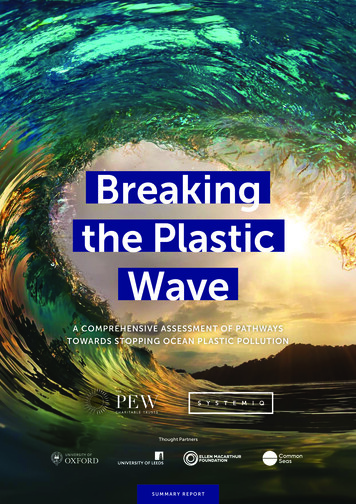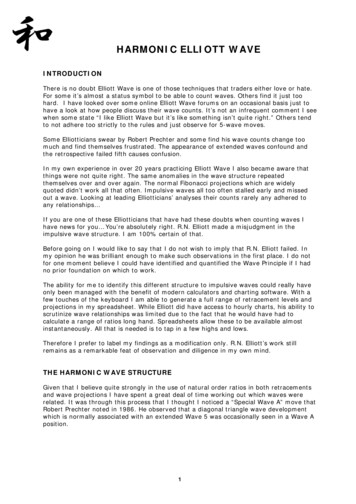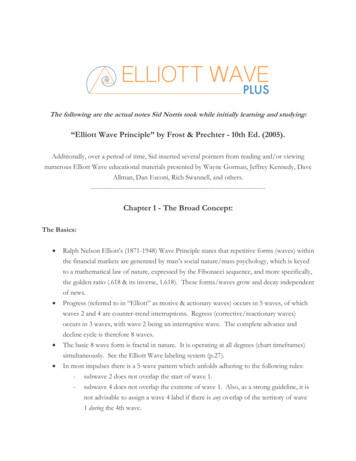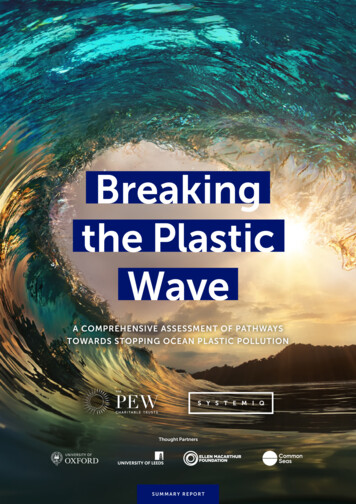
Transcription
Breakingthe PlasticWaveA COMPREHENSIVE ASSESSMENT OF PATHWAYSTOWARDS STOPPING OCEAN PLASTIC POLLUTIONThought PartnersSUMMARY REPORT
XAbout The Pew Charitable TrustsThe Pew Charitable Trusts is driven by the power ofknowledge to solve today’s most challenging problems.Pew applies a rigorous, analytical approach to improvepublic policy, inform the public, and invigorate civic life.As the United States and the world have evolved, wehave remained dedicated to our founders’ emphasis oninnovation. Today, Pew is a global research and public policyorganization, still operated as an independent, nonpartisan,nonprofit organization dedicated to serving the public.Informed by the founders’ interest in research, practicalknowledge, and public service, our portfolio includes publicopinion research; arts and culture; civic initiatives; andenvironmental, health, state, and consumer policy initiatives.Our goal is to make a difference for the public. That meansworking on a few key issues, with an emphasis on projectsthat can produce consequential outcomes, foster new ideas,attract partners, avoid partisanship or wishful thinking, andachieve measurable results that serve the public interest.Learn more at https://www.pewtrusts.org/enFor more information, contact us atPreventingOceanPlastics@pewtrusts.orgAbout SYSTEMIQSYSTEMIQ Ltd. is a certified B Corp with offices in London,Munich, and Jakarta. The company was founded in 2016to drive the achievements of the Paris Agreement andthe United Nations Sustainable Development Goals bytransforming markets and business models in three keyeconomic systems: land use, materials, and energy.Since 2016, SYSTEMIQ has been involved in severalsystem change initiatives related to plastics andpackaging, including the New Plastics Economy initiative(Ellen MacArthur Foundation) and Project STOP (a citypartnership programme focused on eliminating plasticpollution in Indonesia), among others. At the heart of ourwork is the core belief that only a smart combination ofpolicy, technology, funding, and consumer engagementcan address system-level challenges. The global plasticschallenge is no different.Learn more at https://www.systemiq.earth/For more information, contact us atOceanPlastics@systemiq.earthCover: Willyam Bradberry/Shutterstock2BREAKING THE PLASTIC WAVE
Table of contentsPREFACE4EXPERT PANEL5ENDORSEMENTS6TIME FOR A PLASTIC PARADIGM SHIFT8FAST FACTS: ‘BREAKING THE PLASTIC WAVE’ IN NUMBERS12ABOUT THIS PROJECT14TEN CRITICAL FINDINGS161. Business-as-Usual will result in nearly three times more plastic leaking into the ocean in 2040172. Current commitments are inadequate for the scale of the challenge193. Single-solution strategies cannot stop plastic pollution204. Existing solutions can solve about 80 per cent of the problem225. Innovation is essential to a future with near-zero plastic pollution396. The solution is economically viable, but a major redirection of capital investment is required407. The solution brings to life a new plastics economy, with opportunities—and risks—for industry418. Solutions should be differentiated by geography and plastic category429. System change offers co-benefits for the climate, health, jobs, and working conditions4310. An implementation delay of five years would result in an additional 80 million metric tons of plastic going into the ocean45ALL STAKEHOLDERS HAVE A GHT PARTNERS54A Comprehensive Assessment of Pathways Towards Stopping Ocean Plastic Pollution3
PrefaceIn recent years, an increasing number of studies and reportshave advanced the global understanding of the challengeposed by ocean plastic pollution. But most leaders acrossindustry, government, and civil society have noted a criticalgap: an evidence-based roadmap to describe the pathwaysavailable and to foster convergent action.As a step towards building that roadmap, The Pew CharitableTrusts partnered with SYSTEMIQ to build on previous researchand create this first-of-its-kind model of the global plasticssystem, with results suggesting that there is an evidence-based,comprehensive, integrated, and economically attractivepathway to greatly reduce plastic pollution entering ourocean. The findings of our analysis were published in thepeer-reviewed journal, Science on 23 July 2020.The speed at which ocean plastic pollution has climbed upthe public agenda has been surprising. Yet, even as the worldstarts to comprehend the enormity of the challenge, majoractors disagree on the solution. In preparing “Breaking thePlastic Wave: A Comprehensive Assessment of PathwaysTowards Stopping Ocean Plastic Pollution,” we consultedan extensive group of stakeholders from academia, industry,government, and nongovernmental organizations, whowithout exception shared the concern and demonstratedwillingness to act—but often offered contradictory solutions.We then developed perhaps the most comprehensiveplastic system modelling tool to create a global analysis thatevaluates various strategies to reduce ocean plastic flowsand quantifies the associated economic, environmental,and social implications of each pathway. The ultimate aim ofthis work is to help guide policymakers, industry executives,investors, and civil society leaders through highly contested,often data-poor, and complex terrain. Our analysis includesseveral key findings that could help define changes to theglobal system that are necessary to stop plastic pollutionfrom flowing into the ocean.The research supporting this report involved 17 expertsfrom across the spectrum of people looking at theplastic pollution problem and with broad geographicalrepresentation, and was undertaken by our two independentorganizations in collaboration with four partner institutions—the University of Oxford, University of Leeds, Ellen MacArthurFoundation, and Common Seas.In addition, the project team drew upon major publications,analyses, and reports, and consulted more than 100independent experts, to develop and populate the model.These experts represented the plastic supply chain,academia, and civil society, and neither they nor theirinstitutions necessarily endorse the report’s findings.“Breaking the Plastic Wave” follows two reports from theEllen MacArthur Foundation that established the visionof a circular economy, aimed at eliminating waste andencouraging the continual use of resources by reusing,redesigning, and recycling. This concept has garneredunprecedented support across the global plastics system.4BREAKING THE PLASTIC WAVEBy highlighting the systemic link between better plasticdesign, reuse, improved recycling economics, and increasedcollection incentives, these reports provided a central themefor the challenge addressed in “Breaking the Plastic Wave”:how to apply the concept of a circular economy—along withincreased reduction and substitution of plastics, and betterwaste management—in a way that urgently addresses thisserious environmental challenge.The model is already being applied at the national level inIndonesia under the public-private collaboration GlobalPlastic Action Partnership. Our hope is that the results of“Breaking the Plastic Wave” can serve as a map for policyleaders, decision-makers, and businesses in search ofsolutions to stem the flow of plastic into the ocean. Thismodel can also be updated by stakeholders on an ongoingbasis to inform solutions to the plastics pollution problem.The problem of ocean plastic pollution was created in alifetime, and we have reason to believe that it can be solvedwithin a generation, or sooner. But such a solution requirespolitical leaders, policymakers, business executives, andinvestors to shift from incremental to systemic change.Among our findings, one is particularly stark: On the currenttrajectory, which we call Business-as-Usual, annual flowsof plastic into the ocean could nearly triple by 2040. What’smore, even if all current major industry and governmentcommitments are met, the world would see a reduction inannual rates of plastic pollution flowing into the ocean ofonly 7 per cent from the Business-as-Usual scenario.Yet we also show that if the world were to apply and robustlyinvest in all the technologies, management practices, andpolicy approaches currently available—including reduction,recycling, and plastic substitution—in 20 years there wouldbe about an 80 per cent reduction from the currenttrajectory in the flow of plastic into the ocean. And thenew solutions recommended in this report would provideconsumers with the same services that plastic deliverstoday—at a lower cost to society.We hope that the “Breaking the Plastic Wave” concepts, data,and analyses inform decision-makers who are responsiblefor setting industry and government action. The report’smost important message is that, with the right level ofaction, tackling the problem of plastics pollution may beremembered as a success story on the human ability torethink and rebuild systems that can sustainably support livesand livelihoods while the environment thrives.Martin R. StuchteyTom DillonFounder & Managing PartnerSYSTEMIQVice President & Head of EnvironmentThe Pew Charitable Trusts
Expert panelThis work was developed in partnership with an expert panel representing all relevant disciplines and geographies:Richard BaileyProfessor ofEnvironmental SystemsUniversity of OxfordJulien BoucherCo-founderQuantis and ShapingEnvironmental ActionJill BoughtonFounderWaste2Worth InnovationsArturo CastilloResearch fellowImperial College LondonMao DaExecutive directorShenzhen Zero WasteEnzo FavoinoResearcherScuola Agraria del Parcodi MonzaMalati GadgilIndependent consultantInformal sector wastemanagementLinda GodfreyPrincipal researcherCouncil for Scientificand Industrial ResearchJutta GutberletProfessorUniversity of VictoriaEdward KosiorManaging directorNextekCrispian LaoFounding presidentPhilippine Alliance forRecycling and MaterialSustainabilityDaniela LerarioTriciclos BrazilEllie MossSenior adviserEncourage CapitalDaniella RussoCo-founder and CEOThink Beyond PlasticUssif Rashid SumailaProfessorUniversity of BritishColumbiaRichard ThompsonProfessorUniversity of PlymouthCostas VelisLecturerUniversity of LeedsA Comprehensive Assessment of Pathways Towards Stopping Ocean Plastic Pollution5
EndorsementsInger Andersen, U.N. under-secretary-general and executive director, United Nations EnvironmentProgramme (UNEP)“Breaking the Plastic Wave: A Comprehensive Assessment of Pathways Towards Stopping Ocean PlasticPollution” comes at a critical time to inform global discussions and help decision-makers evaluate options thatwill eliminate the long-term flow of plastic and microplastics into the ocean. By providing the evidence basefor a way forward, the study convincingly shows the need for system-wide change and urgent action acrossthe entire value chain. It inspires by demonstrating that projected plastic leakage can be reduced by 80% withexisting solutions. The next two years will be critical in getting the world on a zero-plastic pollution path. Weneed to catalyse rapid transition; we need to act now!”Marisa Drew, CEO, impact advisory and finance department, Credit Suisse“Despite the awareness-raising and global efforts to reduce plastic production, consumption, and waste in ouroceans, the current trajectory points to a dire outcome without a concerted effort to mobilise industry, civilsociety, and governments to address this critical environmental issue. This well-researched, peer-reviewed reportfrom The Pew Charitable Trusts and SYSTEMIQ provides a roadmap for the investment and innovation requiredto tackle the challenge. The report also shows us that economically viable solutions exist today thatare implementable if all relevant stakeholders across the value chain act with urgency.Professor Juliet A. Gerrard, chief science advisor to the Prime Minister of New Zealand“This is a seminal piece of work on a topic of global importance. It will guide countries to align and unite as wemove to conquer the plastic problem.”Von Hernandez, global coordinator, Break Free From Plastic“Break Free From Plastic (BFFP) welcomes “Breaking the Plastic Wave” as a helpful addition to the globalconversation about this rapidly growing threat to human and ecosystem health. “Breaking the Plastic Wave”demonstrates that no solution to the plastic crisis is possible without prioritizing urgent action to reduce thequantity of plastic used and produced. The report makes clear that existing private-sector commitments andpublic policies to limit plastic pollution are wholly inadequate and demonstrates that industry’s expansionplans will produce even more staggering quantities of plastic pollution, greenhouse gas emissions, andirreversible damage to the ocean. While we agree with the report’s general recommendation calling for aradical system change in how the world deals with plastic, we disagree that certain technologies analyzedin the report—including incineration, chemical recycling, and plastic-to-fuel—are part of that solution, asthey will only perpetuate the problem as we see it. Above all, this report should serve as a wake-up call togovernments: They must step in to halt the expansion of plastic production. Only then can we begin to seesignificant and sustained decline of plastic leakage into the oceans and to the environment.”Her Excellency Ms. Thilmeeza Hussain, ambassador of the Maldives to the United States and permanentrepresentative of the Maldives to the United Nations“This report is an important contribution to understanding the nature of the marine plastic pollution problem andprovides many important ideas and proposals that diplomats and other actors will need to consider in decidinghow the global community can effectively address this pressing problem.”Ramon Laguarta, chairman and CEO, PepsiCo“Addressing the challenge of plastic waste is both urgent and complex and will require accelerated, collectiveaction and a transformation of the way society thinks about single-use plastics. This report calls for immediatebold action in the global effort to stem the tide of ocean plastics. It makes clear that through increasedcollaboration, across industries, we can help create systems change, build a circular economy for packaging,and turn the corner on ocean plastics.”6BREAKING THE PLASTIC WAVE
Dame Ellen MacArthur, founder and chair of trustees, Ellen MacArthur Foundation“Breaking the Plastic Wave” brings an unprecedented level of detail into the global plastic system, confirmingthat without fundamental change, annual flows of plastic into the ocean could nearly triple by 2040. To turnthe tide on plastic waste and pollution, we need to radically increase our efforts and speed up the transitionto a circular economy. We must eliminate the plastics we don’t need, and drastically reduce virgin plastic use.We need to innovate to create new materials and business models based on reuse and refill systems. Andwe need improved infrastructure to ensure that all plastics we use are circulated in the economy and neverbecome waste or pollution. The question is not whether a circular economy for plastic is possible, but whatwe will do together to make it happen.”Grant Reid, CEO, Mars Inc.“We applaud the depth and rigor of this report on what’s necessary to stop ocean plastic pollution. Mars iscommitted to being a part of the transformational system change that this issue requires. We’re taking actionby removing packaging we don’t need, exploring reuse models, redesigning what we do need for circularity,and investing to close the packaging waste loop with recycling systems that work for business and communities.We have much to do, so we must work together as a global community like never before.”Erin Simon, head, plastic and business, World Wildlife Fund“If we’re going to significantly reduce ocean plastic pollution, we need an innovative and rigorous approach toensure that the strategies we design are set up to delivering results. This research does exactly that. By identifyinga modelling approach that looks at plastic pollution holistically, we’re able to better measure the environmental,economic, and social impact of the strategies being considered, and call for a greater level of ambition andimmediate action from all stakeholders. This deeper understanding will help companies, governments, and otherstakeholders to strengthen their efforts on plastic pollution. It will continue to be crucial to monitor and evaluatestrategies on the ground to ensure that we as a society are delivering against our ambition.”Andrew Steer, president and CEO, World Resources Institute“The ocean is being filled with plastic—hurting sea life and the billions of people who depend on the oceanfor food, livelihoods and recreation. This is entirely unnecessary and unacceptable. This new important report,“Breaking the Plastic Wave” presents important solutions that can reduce plastic flows by 80% over the next20 years. It is urgent that industry and government leaders follow these recommendations – starting today.”Laura Tuck, vice president for sustainable development, World Bank*“The plastic problem took a lifetime to create and could be solved in a generation. That’s the stark messageof “Breaking the Plastic Wave,” a welcome and comprehensive look at what we need to do—at every layer ofsociety—to clean up the mess we are making. Its positive message is that we already have the solutions weneed to address the challenge. But we will need to step up with multi-stakeholder coalitions that can tackleeach element of the agenda as they are laid out here.”* Retired from the World Bank as of April 1, 2020Melati Wijsen, founder, Bye Bye Plastic Bags“Since starting to campaign against plastic pollution at 12 years old, I have seen numerous efforts come andgo. Being born and raised in Bali, Indonesia, it was like watching the problem of plastic grow up with you. Thisis why we understood early on the importance of data and consistency. It is beyond exciting to hear that myhome country has already applied the model featured in “Breaking the Plastic Wave.” The only way forward iscollaboration and persistence; let’s turn the tide on plastic pollution once and forever.”A Comprehensive Assessment of Pathways Towards Stopping Ocean Plastic Pollution7
XTime for a plasticparadigm shiftPlastic waste in Pattaya, ThailandLeonid Danilov/Pexels8BREAKING THE PLASTIC WAVE
TIME FOR A PLASTIC PARADIGM SHIFTPlastic pollution is getting worse, and fast. Solving this growing problem requires creating a plasticseconomy that is smart, sustainable, and circular.Plastic production, first developed in the 19th century,soared during the 20th century, from 2 million metric tons in19501 to 348 million metric tons in 2017,2 becoming a globalindustry valued at US 522.6 billion,3 and it is expected todouble in capacity yet again by 2040.4 As plastic productionand use have surged, so too has plastic pollution, and withit the amount of plastic in the ocean,5 which could be about150 million metric tons.6And, yet, a coherent global strategy to solve this urgentproblem remains elusive. Very different responses have beenproposed, from eliminating plastic entirely to turning it intofuels, and from developing biodegradable substitutes torecycling plastic back into usable products. Each solutioncomes with advantages and drawbacks. Understandingthe effectiveness of different solutions, and the associatedeconomic, environmental, and social implications, is crucialto making progress towards stopping ocean plastic pollution.From coral reefs7 to deep sea trenches8 and from remoteislands9 to the poles,10 plastic alters habitats, harms wildlife,and can damage ecosystem function and services.11 Morethan 800 species are already known to be affected bymarine plastic pollution, including all sea turtle species,12more than 40 per cent of cetacean species, and 44 percent of marine bird species.13 Plastic has also been identifiedas having human health impacts throughout its life cycle,from the effects of raw material extraction and productionon neighbouring communities14 to the chemicals in foodpackaging15 and the health impacts of mismanaged waste.16Plastic pollution is not only an environmental tragedy, it is alsoeconomically imprudent—billions of dollars of economic valueare “thrown away” after a single, short use. It is a by-productof fundamental flaws in an essentially linear plastic systemin which 95 per cent of aggregate plastic packaging value—US 80 billion to US 120 billion a year—is lost to the economyfollowing a short one-use cycle.17 Although the challenge isenormous, our report gives cause for optimism. It shows thata significant reduction in projected plastic leakage is possible—without compromising social or economic benefits—if wetake urgent actions across the entire plastic system.Ten critical findings emerge from our analysis, assummarized below. More details on each finding areincluded in the next section.1Without action, the annual flow of plastic into the oceanwill nearly triple by 2040, to 29 million metric tons per year(range: 23 million-37 million metric tons per year), equivalentto 50 kg of plastic for every metre of coastline worldwide.This trend will have serious consequences for communities,ecosystems, and businesses. Under the Business-as-Usual(BAU) Scenario, approximately 4 billion people are likely tobe without organized waste collection services by 2040,contributing significantly to the mass of plastic leaking intothe ocean. The cost of inaction is high for all stakeholders;particularly stark is the US 100 billion annual financial risk thatbusinesses face if governments require them to cover wastemanagement costs at expected volumes and recyclability.2Governments and industry leaders are stepping up withnew policies and voluntary initiatives, but these are oftennarrow in focus or concentrated in low-leakage countries.By 2040, current government and industry commitments arelikely to reduce annual plastic leakage into the ocean by only7 per cent ( 1 per cent) relative to BAU. Our results indicate thata far greater scale of action at the system level will be requiredto address the challenge of plastic pollution. Governmentpolicies and leadership by consumer goods companies willbe critical in driving upstream action on reduction, reuse, andredesign. Governments and investors also should act fast tocurtail the planned expansion in plastic production capacity toprevent locking us deeper into the status quo.3There is no single solution to end ocean plastic pollution.Upstream and downstream solutions should be deployedtogether. To date, much of the debate has focused on either“upstream” (pre-consumer, such as material redesign, plasticreduction, and substitution) or “downstream” solutions(post-consumer, such as recycling and disposal). Our analysisshows that this is a false dichotomy. Modelled on their own,none of the “single-solution” strategies reduce annual leakageof plastic into the ocean even below 2016 levels by 2040. Anambitious recycling strategy, for example, with scale-up ofcollection, sorting, and recycling infrastructure, coupled withdesign for recycling, reduces 2040 leakage by 38 per cent ( 7per cent) relative to BAU, which is 65 per cent ( 15 per cent)above 2016 levels. An integrated approach with new ways todeliver the benefits of today’s plastic is required.4Industry and governments have the solutions today to reducerates of annual land-based plastic leakage into the ocean byabout 80 per cent (82 13 per cent) below projected BAUlevels by 2040, while delivering on other societal, economic,and environmental objectives. Under our System ChangeScenario, 30 per cent (range: 27 per cent-32 per cent) of BAUplastic demand is reduced, 17 per cent (range: 15 per cent-18per cent) is substituted, 20 per cent (range: 18 per cent-21 percent) is recycled, 23 per cent (range: 22 per cent-26 per cent)is disposed and 10 per cent (range: 9 per cent-12 per cent)remains mismanaged. It is not the lack of technical solutionsthat is preventing us from addressing plastic pollution, butrather inadequate regulatory frameworks, business models,and funding mechanisms. The incentives are not alwaysin place to scale up changes fast enough. A reduction ofplastic production—through elimination, the expansion ofconsumer reuse options, or new delivery models—is the mostattractive solution from environmental, economic, and socialperspectives. It offers the biggest reduction in plastic pollution,often represents a net savings, and provides the highestmitigation opportunity in greenhouse gas (GHG) emissions.A Comprehensive Assessment of Pathways Towards Stopping Ocean Plastic Pollution9
TIME FOR A PLASTIC PARADIGM SHIFT58Going beyond the System Change Scenario to tacklethe remaining 5 million metric tons per year (range: 4million-7 million metric tons per year) of plastic leakagedemands significant innovation across the entire plasticsvalue chain. Achieving the vision of near-zero oceanplastic pollution will require technological advances,new business models, significant spending, and, mostcrucially, accelerating upstream innovation. It will requirea focused, well-funded R&D agenda, including moon-shotambitions, to help middle-/low-income countries leapfrogthe unsustainable linear economy model of high-incomecountries. Most crucial will be innovations that work in rural/remote areas, that eliminate multilayer and multimaterialplastics, and that lead to new tyre designs that minimize tyredust while maintaining safety standards.A system change would require different implementationpriorities in different geographies and for differentplastic categories. High-income countries should prioritizedecreasing overall plastic consumption, eliminatingmicroplastic leakage, improving product design, andincreasing recycling rates. Middle-/low-income countriesshould prioritize expanding formal collection, maximizingreduction and substitution, investing in sorting and recyclinginfrastructure, and cutting post-collection leakage. Globally,the top priority is reducing avoidable plastic, of which therewill be 125 million metric tons (range: 110 million metrictons-142 million metric tons) globally by 2040 under BAU.Similarly, we should prioritize solutions universally for thehighest-leakage plastic categories. Flexible packaging(bags, films, pouches, etc.) and multilayer and multimaterialplastics (sachets, diapers, beverage cartons, etc.) accountfor a disproportionate share of plastic pollution comparedwith their production, making up 47 per cent (range: 34 percent–58 per cent) and 25 per cent (range: 17 per cent–34 percent) of the leakage mass, respectively.6The System Change Scenario is economically viable forgovernments and consumers, but a major redirection ofcapital investment is required. The present value of globalinvestments in the plastic industry between 2021 and 2040can be reduced from US 2.5 trillion ( US 800 billion) toUS 1.2 trillion ( US 300 billion), but the System ChangeScenario will require a substantial shift of investment awayfrom the production and conversion of virgin plastic, whichare mature technologies perceived as “safe” investments, tothe production of new delivery models, plastic substitutes,recycling facilities, and collection infrastructure, someof which are less mature technologies and perceived asriskier. This shift will require government incentives andrisk-taking by industry and investors. The total global costto governments of managing plastic waste in the SystemChange Scenario between 2021 and 2040 is estimated tobe US 600 billion (range: US 410 billion-US 630 billion)in present value, compared to the US 670 billion (range:US 450 billion-US 740 billion) cost to manage a highleakage system under BAU.7Reducing approximately 80 per cent (82 13 per cent)of plastic leakage into the ocean will bring to life a newcircular plastics economy with major opportunities—andrisks—for industry. Today, plastic pollution presents aunique risk for producers and users of virgin plastics givenregulatory changes and growing consumer outrage. Butit is also a unique opportunity for companies ahead of thecurve, ready to unlock value from a circular economy thatderives revenue from the circulation of materials rather thanthe extraction and conversion of fossil fuels. Large new valuepools can be created around better design, better materials,better delivery models, improved sorting and recyclingtechnologies, and smart collection and supply chainmanagement systems. Under the System Change Scenario,we could fulfil the growing global demand for “plastic utility”in 2040 with roughly the same amount of plastic in thesystem as today, and 11 per cent ( 1 per cent) lower levels ofvirgin plastic production. This scenario essentially decouplesplastic growth from economic growth.10BREAKING THE PLASTIC WAVE9Addressing plastic leakage into the ocean under theSystem Change Scenario has many co-benefits for climate,health, jobs, working conditions, and the environment,thus contributing to many of the United NationsSustainable Development Goals. The scenario results in 25per cent ( 11 per cent) lower plastic-related GHG emissionsin 2040, although still an increase relative to today. Peak virginplastic production is reached by 2027. In addition, net directemployment in the plastics value chain increases by 700,000jobs (range: 541,000-795,000), almost all of them in middle-/low-income countries. A rise in plastic material value throughdesign for recycling can also contribute to social justicefor the world’s 11 million waste pickers, who in 2016 wereresponsible for 60 per cent (range: 56 per cent-65 per cent)of global plastic recycling, by increasing the retained value ofplastic and improving working conditions. Health hazards arealso reduced, including through the reduction of 109 million(range: 108 million-111 million) metric tons per y
and that cultural norms and consumer behaviours do not . change. 2. Current Commitments Assumes that all major commitments already made by . the public and private sectors between 2016 and 2019 are . implemented and enforced. These commitments include existing bans/levies on specific plastic products, and recycling and recyclability targets. 3.










